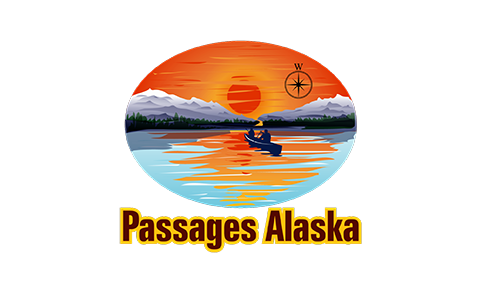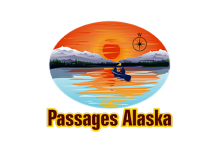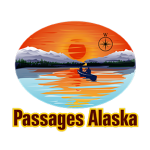
The day breaks in the Southeast Alaska wilderness with sounds of bald eagles or resident Canadian Geese welcoming us. Traveling along the salty waterways by canoe in the morning so as to have the best paddling water creates the goal for an early start. Once camp is packed up and breakfast eaten we load the canoes and join on the water for morning gratitude circle. Each member expresses gratitude for whatever seems important to them at the time. The circle closes with all paddles held high in the air and a shout of THANK YOU ALASKA!
The guides have shared paddling destinations and distances in general terms. Student team members will be working on navigation and they will have worked, with those guides, to have established the route and direction of paddle, taking into consideration weather, wind, and tides. On average the group will travel between 7 and 8 miles per day. Paddling offers a very concrete way of understanding how our actions influence the direction in which we travel. Literally and used as a metaphor, students learn how slight corrections can keep a canoe moving in a straight line and how inattention of their paddle strokes leads to an erratic pattern. They learn that teamwork makes travel much easier than random individual effort. Canoe paddling is a very interactive means of active meditation.
Along the day’s travels sea otters, harbor seals, humpback whales, orcas and a wide variety of sea birds are frequent travel companions for the group.
Lunchtime will find the travelers on one of a huge number of beaches that has what one student referred to as “screen saver views.” Nature’s beauty is everywhere here, and in most cases, the places we stop, or camp have had no other human visitors.
Camp is usually a couple hours paddle beyond wherever we stop for lunch and the team arrives by midafternoon. Setting up camp, finding makings for a fire, and getting the evening meal prepared are the first orders of business.
Team members all take turns filling the essential roles that help things run smoothly. When salmon are abundant during late summer dinner is often as not, fresh-caught Alaska Salmon with other choices for those not inclined to a salmon dinner.
After mealtime and clean up, comes individual check-ins with staff. Students rate themselves on goal achievement and various aspects of their day, staff then compares their own observations with the identified student. Staff asks questions about health and completes the daily activity notes with students.
The final activity of the day is Truth Circle. Team members all take turns leading the circle where each member is encouraged to share both high points and low points of the day, and their thoughts about a new themed topic of discussion. After the Truth Circle, team members have some time for individual pursuits and reflection.
Bedtime finds team members comfortably off the ground, in their hammocks under cover of a tarp; a proven stay dry formula in our temperate rainforest environment.
Weather permitting, we like to travel 5 days a week. Safety is our first concern and some days, staying ashore is the safer choice. On layover days, there is time for field showers, laundry, relaxing, letters home, clinician visits and personal time.
On staff change day, everyone, students and staff alike, circle up on the beach to discuss the past week and plan for the coming week. We believe strongly in a collaborative approach where both students and staff are challenged to grow and examine their own process and function in the group.
Increased mindful living is the overarching goal at Passages Alaska.











